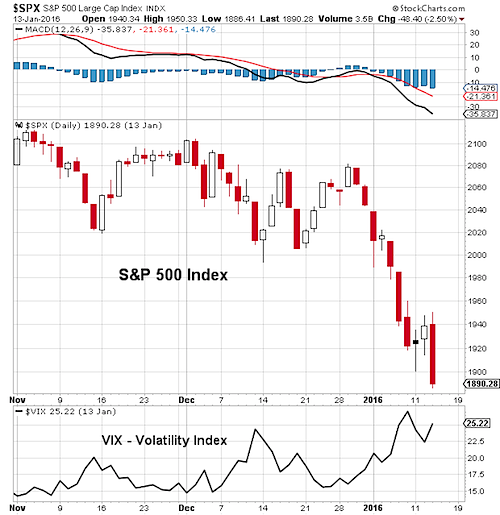This post was written with Bruce Bittles, a fellow strategist at Robert W. Baird & Co.
The carnage continues in stock markets around the world with many areas hitting new 52-week lows as market volatility remains elevated. Today we provide a stock market update, as signs of panic have emerged in the equity markets.
What started out as a response to China’s market volatility has gathered momentum aggravated by some of the problems that faced stocks in 2015. Valuation concerns we had last year have been carried forward into 2016.
The last two years, earnings have been flat, and far below forecast. Equity markets can stay overvalued for long periods of time and therefore valuation indictors are a poor tool for projecting stock prices. But when stock market valuations are stretched, it makes equities more vulnerable to an outside shock. Consensus estimates are that earnings will grow 19% this year, which would require virtually everything going right in the economy. Earnings growth estimates are likely overstated but should earnings grow half of what is anticipated, combined with a correction in equity prices, stocks will become a greater value. Corporate earnings face much easier comparisons this year and, should the dollar stabilize, bottom-line growth is possible.
Technically, we are encouraged by the fact that investor sentiment has turned excessively pessimistic. Yesterday’s report from Investors Intelligence, which tracks the opinion of Wall Street letter writers, showed a sharp drop in bulls to 25%, down from 57% at high in April last year. The bears jumped to 36%, up from 15%. These readings are similar to those found at the stock market lows in 2011 and at last September‘s bottom – perhaps signs of fear and panic.
Today we will receive the latest survey of investor sentiment from the American Association of Individual Investors (AAII). Last week, there were nearly twice as many bears than bulls in the AAII data, a jump to three times is unusual but often found at a good market low.
 The CBOE Volatility Index (VIX) is at 25, and a move to 30 would also signal extreme fear has entered the market. The CBOE three-day put/call ratio this week was at the highest level in four years also reflecting a very nervous investment climate. We are also encouraged today by the high market volatility and panic selling in the FANG and so-called nifty 12 stocks that ruled the market in 2015. Typically, these issues have been heavily shorted and, therefore, the last to fall.
The CBOE Volatility Index (VIX) is at 25, and a move to 30 would also signal extreme fear has entered the market. The CBOE three-day put/call ratio this week was at the highest level in four years also reflecting a very nervous investment climate. We are also encouraged today by the high market volatility and panic selling in the FANG and so-called nifty 12 stocks that ruled the market in 2015. Typically, these issues have been heavily shorted and, therefore, the last to fall.
The key to the potential for a sustainable rally will likely be found in the performance for the broad market in the coming weeks. Last year, the strength in the popular averages was overstated by a small number of issues. In 2015, 301 S&P 500 issues were down 10% or more and 175 stocks were down 20%. In a healthy, market most areas are in gear.
To get aggressive on the long side would require the downside momentum to be broken by at least one day where upside volume exceeds downside volume by a ratio of 10 to 1 or more. It will also be important that the Dow Transports, which are often a leading indicator for the market and the economy, begin to regain their footing. The Transports have been the leading edge on the downside and that needs to be reversed to gain confidence a stock market low is in place.
We are encouraged by the fact that the Dow Industrials and S&P 500 have not broken their September lows thus providing a positive divergence. Should the Dow and S&P 500 close below last year’s lows, however, that would be a negative and argue that most areas of the market are in gear on the downside.
Bottom Line: Considerable damage to the Tape and a less friendly Fed requires avoiding bottom fishing until a momentum reversal occurs. A lower opening would also be beneficial as opposed to strong beginning that invites selling.
Thanks for reading.
Twitter: @WillieDelwiche
Any opinions expressed herein are solely those of the author, and do not in any way represent the views or opinions of any other person or entity.








